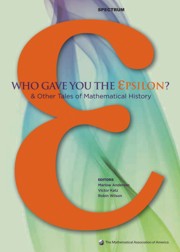Book contents
- Frontmatter
- Introduction
- Contents
- Analysis
- Geometry, Topology and Foundations
- Algebra and Number Theory
- Foreword
- Hamilton's Discovery of Quaternions
- Hamilton, Rodrigues, and the Quaternion Scandal
- Building an International Reputation: The Case of J. J. Sylvester (1814–1897)
- The Foundation Period in the History of Group Theory
- The Evolution of Group Theory: A Brief Survey
- The Search for Finite Simple Groups
- Genius and Biographers: The Fictionalization of Evariste Galois
- Hermann Grassmann and the Creation of Linear Algebra
- The Roots of Commutative Algebra in Algebraic Number Theory
- Eisenstein's Misunderstood Geometric Proof of the Quadratic Reciprocity Theorem
- Waring's Problem
- A History of the Prime Number Theorem
- A Hundred Years of Prime Numbers
- The Indian Mathematician Ramanujan
- Emmy Noether
- “ Marvelous Proof,”
- Afterword
- Surveys
- Index
- About the Editors
Eisenstein's Misunderstood Geometric Proof of the Quadratic Reciprocity Theorem
from Algebra and Number Theory
- Frontmatter
- Introduction
- Contents
- Analysis
- Geometry, Topology and Foundations
- Algebra and Number Theory
- Foreword
- Hamilton's Discovery of Quaternions
- Hamilton, Rodrigues, and the Quaternion Scandal
- Building an International Reputation: The Case of J. J. Sylvester (1814–1897)
- The Foundation Period in the History of Group Theory
- The Evolution of Group Theory: A Brief Survey
- The Search for Finite Simple Groups
- Genius and Biographers: The Fictionalization of Evariste Galois
- Hermann Grassmann and the Creation of Linear Algebra
- The Roots of Commutative Algebra in Algebraic Number Theory
- Eisenstein's Misunderstood Geometric Proof of the Quadratic Reciprocity Theorem
- Waring's Problem
- A History of the Prime Number Theorem
- A Hundred Years of Prime Numbers
- The Indian Mathematician Ramanujan
- Emmy Noether
- “ Marvelous Proof,”
- Afterword
- Surveys
- Index
- About the Editors
Summary
The quadratic reciprocity theorem has played a central role in the development of number theory, and formed the first deep law governing prime numbers. Its numerous proofs from many distinct points of view testify to its position at the heart of the subject. The theorem was discovered by Euler, and restated by Legendre in terms of the symbol now bearing his name, but was first proven by Gauss. The eight different proofs Gauss published in the early 1800s, for what he called the fundamental theorem, were followed by dozens more before the century was over, including four given by Gotthold Eisenstein in the years 1844–1845. Our aim is to take a new look at Eisenstein's geometric proof, in which he presents a particularly beautiful and economical adaptation of Gauss's third proof, and to draw attention to all the advantages of his proof over Gauss's, most of which have apparently heretofore been overlooked.
It is hard to imagine today the sensation caused by Eisenstein when he burst upon the mathematical world. In the autumn of 1843, at age twenty, this selftaught mathematician had barely received his high school certificate and entered the Friedrich-Wilhelms University of Berlin, when he produced a flood of publications, instantly making him one of the leading mathematicians of the early nineteenth century. On July 14, 1844, Gauss wrote to C. Gerling:
I have recently made the acquaintance of a young mathematician, Eisenstein from Berlin, who came here with a letter of recommendation from Humboldt. This man, who is still very young, exhibits very excellent talent, and will certainly achieve great things [4].
- Type
- Chapter
- Information
- Who Gave You the Epsilon?And Other Tales of Mathematical History, pp. 309 - 312Publisher: Mathematical Association of AmericaPrint publication year: 2009



